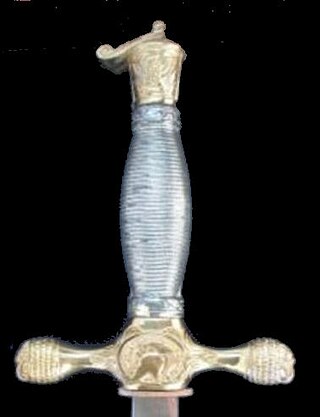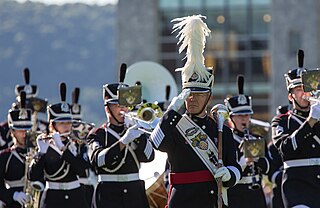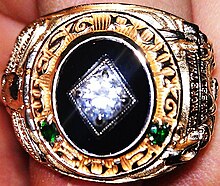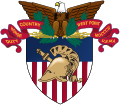
The United States Military Academy (USMA), also known metonymically as West Point or simply as Army, is a United States service academy in West Point, New York. It was originally established as a fort, since it sits on strategic high ground overlooking the Hudson River 50 miles (80 km) north of New York City. It is the oldest of the five American service academies and educates cadets for commissioning into the United States Army.

The United States Air Force Academy (USAFA) is a United States service academy in El Paso County, Colorado, immediately north of Colorado Springs. It educates cadets for service in the officer corps of the United States Air Force and United States Space Force. It is the youngest of the five service academies, having graduated its first class 64 years ago in 1959, but is the third in seniority. Graduates of the academy's four-year program receive a Bachelor of Science degree and are commissioned as second lieutenants in the U.S. Air Force or U.S. Space Force. The academy is also one of the largest tourist attractions in Colorado, attracting approximately a million visitors each year.

Major General Charles Wolcott Ryder CB was a senior United States Army officer who served with distinction in both World War I and World War II.

A cap badge, also known as head badge or hat badge, is a badge worn on uniform headgear and distinguishes the wearer's nationality and/or organisation. The wearing of cap badges is a convention commonly found among military and police forces, as well as uniformed civilian groups such as the Boy Scouts, civil defence organisations, ambulance services, customs services, fire services etc.
Officer Cadet is a rank held by military cadets during their training to become commissioned officers. In the United Kingdom, the rank is also used by members of University Royal Naval Units, University Officer Training Corps and University Air Squadron; however, these are not trainee officers with many not choosing a career in the armed forces.

In the United States, a class ring is a ring worn by students and alumni to commemorate their final academic year and/or graduation, generally for a high school, college, or university.

The Marine Military Academy is a private college preparatory academy located in Harlingen, Texas, US, offering a college preparatory curriculum for boys in grades 7–12 plus one year of post-graduate study. The school was founded in 1965. Its traditions and ideals are inspired by the United States Marine Corps (USMC), but the school is not affiliated with the USMC except through its Junior ROTC program.

The Long Gray Line is a 1955 American Cinemascope Technicolor biographical comedy-drama film in CinemaScope directed by John Ford based on the life of Marty Maher and his autobiography, Bringing Up the Brass, co-written with Nardi Reeder Campion. Tyrone Power stars as the scrappy Irish immigrant whose 50-year career at West Point took him from a dishwasher to a non-commissioned officer and athletic instructor.
Master warrant officer (MWO) is a senior military rank in the Bangladesh Armed Forces, the Canadian Forces, Singapore Armed Forces, the South African National Defence Force and the Israel Defense Forces.

The United States Military Academy Preparatory School (USMAPS), sometimes referred to as West Point Prep, is a preparatory school for the United States Military Academy (USMA). Located in West Point, New York, its official mission is "to provide academic, military and physical instruction in a moral-ethical military environment to prepare and motivate candidates for success at the United States Military Academy."

The Sandhurst Military Skills Competition is a military skills competition at West Point that first began in 1967 with the presentation of a British officer's sword to the United States Corps of Cadets by the British Exchange Officer. 2010's event, dubbed SANCOM10, was a two-day event conducted at West Point, New York. The 2009 competition featured a record 49 teams and nearly 500 competitors. Besides the 36 squads from each of the West Point companies, visiting service academy teams included the Naval, Air Force and Coast Guard Academies, Britain's Royal Military Academy Sandhurst (RMAS) teams "Red" and "Blue", Australia's Royal Military College Duntroon, Canada's Royal Military College (RMC), the National Military Academy of Afghanistan, and the Chilean Military School. That year saw eight ROTC squads: Texas A&M, BYU, East Carolina University, Iowa State University, Florida Tech, Georgetown, University of Hawaii, and Appalachian State.
The uniforms of the United States Army distinguish soldiers from other service members. U.S. Army uniform designs have historically been influenced by British and French military traditions, as well as contemporary U.S. civilian fashion trends. The two primary uniforms of the modern U.S. Army are the Army Combat Uniform, used in operational environments, and the Army Green Service Uniform, worn during everyday professional wear and during formal and ceremonial occasions that do not warrant the wear of the more formal blue service uniform.

The West Point Cadets' Sword is issued to cadet officers of the United States Military Academy at West Point, New York for wear when the uniform is designated as "under arms," to include formal functions, drill, parades, inspections and graduation. The swords are issued to cadets in their First Class (4th) year, and are returned to the Academy upon separation, although Cadets have the option of buying their saber or purchasing a newly made one. Despite its straight blade and lack of a knuckle guard, it is referred to by USMA staff and cadets as a "saber," likely because the commands for its manual of arms utilize that term as the command of execution

The Department of Physical Education is the academic department that oversees the physical development program at the United States Military Academy at West Point, New York. DPE is headquartered in the Arvin Cadet Physical Development Center. DPE has 24 Military faculty and 25 civilian instructors and professors. The head of the department holds the ceremonial title of Master of the Sword, known within the department as the MOS. This title dates back to when the Cadets at West Point were taught swordsmanship as part of their military and physical training. The current Master of the Sword is COL Nicholas Gist, who has held the position since 2015. The department's stated mission is:
The Department of Physical Education develops warrior leaders of character who are physically and mentally tough by engaging cadets in activities that promote and enhance a healthy lifestyle, physical fitness, movement behavior, and psychomotor performance.

The United States Military Academy and grounds were declared a National Historic Landmark in 1960 due to the Revolutionary War history and the age and historic significance of the academy itself. The majority of the buildings in the central cadet area are historic.
The history of the United States Military Academy can be traced to fortifications constructed on the West Point of the Hudson River during the American Revolutionary War in 1778. Following the war, President Thomas Jefferson signed legislation establishing the United States Military Academy (USMA) on the site in 1802. In 1817 the academy was transformed by the appointment of Sylvanus Thayer who drastically reformed the curriculum.

The West Point Band is the U.S. Army's oldest active band and the oldest unit at the United States Military Academy, traces its roots to the American Revolutionary War. At that time, fifers and drummers were stationed with companies of minutemen on Constitution Island, across the river from West Point. In 1778, General Samuel Holden Parsons' 1st Connecticut Brigade crossed the Hudson River and established West Point as a permanent military post. After the American Revolution, Congress disbanded most of the Continental Army, but "the 55 men at West Point", members of the 2nd Continental Artillery, remained as they were. Among their ranks stood at least one drummer and one fifer, who alone maintained the tradition of military music at West Point.
















